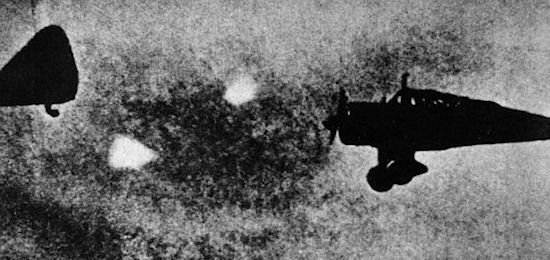In the 1938 comic strip Smokey Stover, a firefighter was known for his line, "Where there's foo, there's fire". From Smokey, aircraft pilots borrowed the term "foo fighter" to describe the various unexplainable phenomenon seen in the skies over Europe and the Pacific theatre during World War II.
While Allied pilots initially thought the flying objects were German secret or psychological weapons, after the war it was discovered that sightings were also reported by the enemy, who had assumed the crafts were US-made. To this day, the sightings remain a mystery.
Over the course of the war, fireballs, estimated to be as big as 300 feet and as small as 1 foot in diameter, were reported and thoroughly documented. These apparitions left witnesses awe-inspired, wary, and frightened although the foo fighters never harmed or attempted to harm anyone. The CIA was commissioned in 1952 to study the reports and concluded that while mysterious, foo fighters were not a considered a threat to national security.
A Foo fighter is an umbrella term that includes flying objects of various shapes and sizes. Wobbling, or vibrating flares were described as glowing globes of intense green, yellow, red, orange, or white lights. One crew even reported observing the phosphorescent spheres going through a sequence of color changes at regular intervals. Other reports describe them as silver or gold metallic, and disk-shaped. They frequently appeared at the wing tips of planes in pairs or alone, although sometimes they were found in larger clusters of fifteen or more.
In one report 150 objects were estimated to be arranged in 10-12 lines. Picking up an aircraft, these blobs of fire could reportedly pace a plane at very high speeds through extensive evasive maneuvers for several minutes. One British officer and his crew of sailors tracked an object from the deck of their vessel for over an hour. Although a few baffled pilots attempted to intercept, and even fire upon the globes, their efforts were unsuccessful, and the objects usually zoomed away of their own accord.
Foo fighters were mentioned in the American mass media. Ponderous articles appeared in Time and Newsweek in 1945, contributing to the wave of UFO consciousness building in the US. By 1952 so many civilians were contacting government agencies regarding UFO reports that regular intelligence work was being affected. While scientists have never been able to explain the phenomenon, many speculations have been advanced as possibilities.
Five of the most plausible theories are:
1. The fireballs may be nothing more than St. Elmo's Fire, a reddish brush-like discharge of atmospheric electricity which has often been seen near the tips of church steeples, ships' masts and yardarms. It also appears at a plane's wing tips.
2. They may have been optical illusions, mere after-images of light remaining in pilots' eyes after being dazzled by flak bursts.
3. Occurrences may have been the rare effect of fireball lightning, a glowing, drifting bubble of light typically eight inches in diameter. These generally, though not always, follow regular lightning strikes.
4. Bright ground objects reflected from the curved plastic canopy of an aircraft can be perceived as images above the horizon.
5. Proponents of the extraterrestrial hypothesis (ETH) have suggested that foo fighters are hard evidence of ETs visiting earth.
Foo fighters are certainly some of the best documented reports of UFOs, and photographs and respected testimony abound. Hopefully in time the mystery will be solved, and this comic book name will be replaced by its true name.




